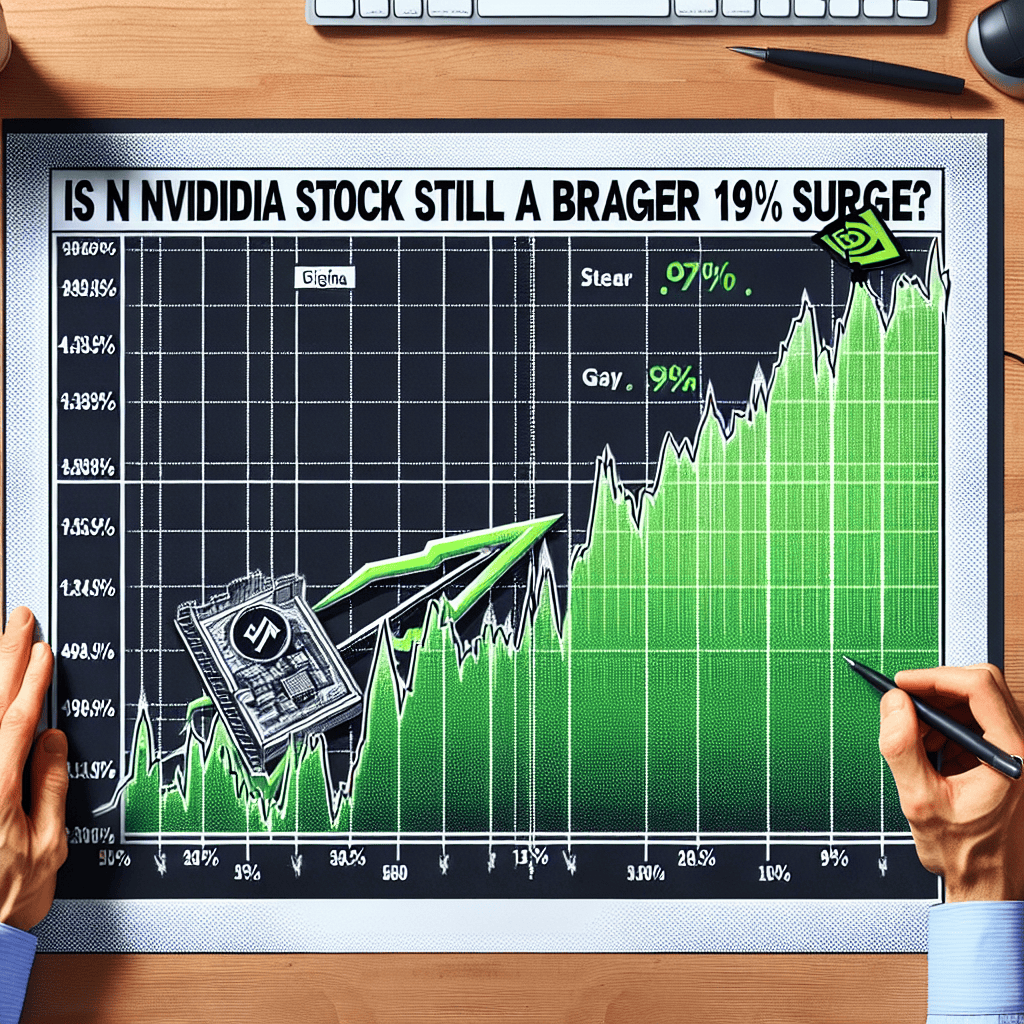“Riding the Wave: Evaluating Nvidia’s Value Post-Surge”
Introduction
Nvidia Corporation, a leading player in the semiconductor industry, has experienced a remarkable surge in its stock price, climbing 190% over a recent period. This impressive rally has captured the attention of investors and market analysts alike, prompting a critical evaluation of whether Nvidia’s stock still represents a bargain at its current elevated levels. As the company continues to innovate and expand its influence across various sectors, including gaming, data centers, and artificial intelligence, the question arises: does the potential for future growth justify the current valuation, or has the stock become overvalued in the wake of its rapid ascent? This analysis seeks to explore the factors driving Nvidia’s stock performance and assess its investment potential in the context of its recent surge.
Analyzing Nvidia’s Valuation Post-Surge
Nvidia Corporation, a leading player in the semiconductor industry, has experienced a remarkable surge in its stock price, climbing approximately 190% over a relatively short period. This impressive rally has captured the attention of investors and market analysts alike, prompting a closer examination of whether Nvidia’s stock still represents a bargain at its current valuation. To assess this, it is essential to delve into the factors that have driven this surge, evaluate the company’s financial health, and consider the broader market context.
The primary catalyst behind Nvidia’s meteoric rise has been its dominance in the graphics processing unit (GPU) market, which has seen increasing demand due to the proliferation of artificial intelligence (AI), gaming, and data center applications. Nvidia’s GPUs are renowned for their high performance and efficiency, making them indispensable in these rapidly growing sectors. Furthermore, the company’s strategic investments in AI and machine learning have positioned it as a leader in these transformative technologies, further bolstering investor confidence.
In addition to its technological prowess, Nvidia’s financial performance has been robust. The company has consistently reported strong revenue growth, driven by its expanding product portfolio and successful penetration into new markets. Its balance sheet remains healthy, with substantial cash reserves and manageable debt levels, providing it with the financial flexibility to continue investing in research and development. This financial stability, coupled with its innovative product offerings, has contributed to the positive sentiment surrounding Nvidia’s stock.
However, despite these favorable factors, the question remains whether Nvidia’s current valuation is justified. The stock’s price-to-earnings (P/E) ratio, a common metric used to assess valuation, has reached elevated levels compared to historical averages and industry peers. This suggests that investors are pricing in significant future growth, which may not materialize as expected. Moreover, the semiconductor industry is inherently cyclical, and any downturn in demand could adversely impact Nvidia’s financial performance and, consequently, its stock price.
Another consideration is the competitive landscape. While Nvidia currently holds a dominant position, it faces increasing competition from other semiconductor giants such as AMD and Intel, which are aggressively investing in their own GPU technologies. These competitors are striving to capture market share, potentially eroding Nvidia’s pricing power and profit margins. Additionally, geopolitical tensions and supply chain disruptions pose risks to the semiconductor industry as a whole, which could affect Nvidia’s operations and stock performance.
Furthermore, macroeconomic factors, such as interest rate fluctuations and inflationary pressures, could influence investor sentiment and impact Nvidia’s valuation. Higher interest rates, for instance, could lead to a shift in investor preference towards more stable, income-generating assets, potentially reducing demand for high-growth stocks like Nvidia. Inflationary pressures could also increase production costs, squeezing profit margins and affecting the company’s bottom line.
In conclusion, while Nvidia’s stock has undoubtedly benefited from its technological leadership and strong financial performance, its current valuation reflects high expectations for future growth. Investors must weigh the potential risks, including increased competition, industry cyclicality, and macroeconomic uncertainties, against the company’s growth prospects. As such, whether Nvidia’s stock remains a bargain is contingent upon one’s risk tolerance and investment horizon. A thorough analysis of these factors is crucial for making an informed investment decision in the context of Nvidia’s post-surge valuation.
Market Trends Impacting Nvidia’s Stock Price
Nvidia’s stock has experienced a remarkable surge of 190% over the past year, capturing the attention of investors and market analysts alike. This impressive growth has been driven by a confluence of market trends that have significantly impacted Nvidia’s stock price. As we delve into these trends, it becomes essential to understand whether Nvidia’s stock still presents a bargain for potential investors.
To begin with, the burgeoning demand for artificial intelligence (AI) and machine learning technologies has been a pivotal factor in Nvidia’s stock performance. Nvidia’s graphics processing units (GPUs) are renowned for their ability to handle complex computations, making them indispensable in AI applications. As industries increasingly integrate AI into their operations, Nvidia has positioned itself as a leader in providing the necessary hardware. This demand has translated into robust sales growth, thereby boosting investor confidence and driving up the stock price.
Moreover, the gaming industry has continued to be a significant contributor to Nvidia’s financial success. The company’s GPUs are highly sought after by gamers for their superior performance and graphics capabilities. With the gaming industry experiencing sustained growth, partly fueled by the rise of e-sports and the increasing popularity of virtual reality, Nvidia has capitalized on this trend. The consistent demand for high-performance gaming hardware has provided a steady revenue stream, further supporting the stock’s upward trajectory.
In addition to AI and gaming, Nvidia has made strategic inroads into the automotive sector, particularly in the development of autonomous vehicles. The company’s technology is integral to the processing power required for self-driving cars, and partnerships with major automotive manufacturers have bolstered its position in this emerging market. As the automotive industry gradually shifts towards automation, Nvidia’s involvement in this sector is likely to yield long-term benefits, potentially sustaining its stock growth.
However, it is crucial to consider the broader semiconductor industry landscape when evaluating Nvidia’s stock. The global semiconductor shortage has posed challenges, affecting production timelines and supply chains. While Nvidia has managed to navigate these disruptions relatively well, the ongoing shortage remains a risk factor that could impact future growth. Investors must weigh this uncertainty against the company’s strong market position and growth prospects.
Furthermore, Nvidia’s recent acquisition of Arm Holdings, a leading semiconductor design company, has been a topic of considerable interest. This acquisition, if successfully completed, could significantly enhance Nvidia’s capabilities and market reach. However, regulatory hurdles and potential antitrust concerns have introduced an element of uncertainty. The outcome of this acquisition will likely influence Nvidia’s stock valuation in the coming months.
In light of these factors, the question of whether Nvidia’s stock remains a bargain is complex. The company’s strong performance and strategic positioning in high-growth markets suggest continued potential for appreciation. Nevertheless, the elevated stock price following the 190% surge may prompt some investors to exercise caution, considering the inherent risks and market volatility.
Ultimately, Nvidia’s stock is influenced by a dynamic interplay of market trends, technological advancements, and strategic decisions. While the stock’s impressive rise may deter some from viewing it as a bargain, others may see it as a testament to Nvidia’s resilience and growth potential. As with any investment, thorough analysis and consideration of both opportunities and risks are essential in making informed decisions.
Nvidia’s Growth Potential in Emerging Technologies
Nvidia Corporation, a leading player in the semiconductor industry, has experienced a remarkable surge in its stock price, rising by an impressive 190% over the past year. This dramatic increase has prompted investors and analysts alike to question whether Nvidia stock remains a bargain or if the opportunity for substantial gains has passed. To address this, it is essential to examine Nvidia’s growth potential in emerging technologies, which could provide insight into the company’s future trajectory and its stock’s valuation.
Nvidia’s success is largely attributed to its dominance in the graphics processing unit (GPU) market, where it has consistently outperformed competitors. However, the company’s growth potential extends far beyond traditional GPU applications. One of the most promising areas for Nvidia is artificial intelligence (AI), where its GPUs are increasingly being used to power machine learning and deep learning applications. As AI continues to permeate various industries, from healthcare to automotive, Nvidia’s role in providing the necessary computational power positions it well for sustained growth.
Moreover, Nvidia’s strategic investments in AI have been complemented by its advancements in data center technology. The demand for data centers has surged as businesses and consumers increasingly rely on cloud computing and data-driven applications. Nvidia’s data center segment has become a significant revenue driver, with its GPUs being utilized to accelerate workloads and improve efficiency. This trend is expected to continue, as more companies seek to harness the power of AI and big data, further solidifying Nvidia’s position in this lucrative market.
In addition to AI and data centers, Nvidia is also making strides in the automotive industry, particularly in the development of autonomous vehicles. The company’s DRIVE platform, which provides the computational foundation for self-driving cars, has garnered attention from major automakers and technology companies. As the race to develop fully autonomous vehicles intensifies, Nvidia’s expertise in AI and GPU technology could prove invaluable, offering another avenue for growth.
Furthermore, Nvidia’s foray into the metaverse—a virtual reality space where users can interact with a computer-generated environment and other users—presents yet another growth opportunity. The metaverse is expected to revolutionize how people work, play, and socialize, and Nvidia’s Omniverse platform is designed to facilitate the creation and operation of these virtual worlds. As interest in the metaverse grows, Nvidia’s technology could become a critical component in its development, driving demand for its products.
While Nvidia’s growth potential in these emerging technologies is undeniable, it is important to consider the risks and challenges that could impact its stock valuation. The semiconductor industry is highly competitive, with rapid technological advancements and potential supply chain disruptions posing significant threats. Additionally, regulatory scrutiny and geopolitical tensions could affect Nvidia’s operations and market access.
Despite these challenges, Nvidia’s strong track record of innovation and strategic positioning in high-growth markets suggest that the company is well-equipped to navigate potential obstacles. Consequently, while the stock’s recent surge may have diminished its appeal as a bargain, Nvidia’s long-term growth prospects in AI, data centers, autonomous vehicles, and the metaverse remain compelling. Investors should weigh these factors carefully, considering both the opportunities and risks, to determine whether Nvidia stock aligns with their investment objectives.
Comparing Nvidia’s Performance with Industry Peers

Nvidia’s remarkable 190% surge in stock value has captured the attention of investors and analysts alike, prompting a closer examination of its performance relative to industry peers. As the semiconductor industry continues to evolve, Nvidia’s growth trajectory raises questions about its sustainability and whether the stock remains a bargain. To understand Nvidia’s position, it is essential to compare its performance with other key players in the semiconductor sector, such as AMD, Intel, and Qualcomm.
Nvidia’s impressive stock performance can be attributed to several factors, including its dominance in the graphics processing unit (GPU) market and its strategic expansion into artificial intelligence (AI) and data centers. The company’s GPUs are widely recognized for their superior performance, making them the preferred choice for gaming, professional visualization, and increasingly, AI applications. This diversification has allowed Nvidia to capitalize on the growing demand for AI-driven technologies, positioning it as a leader in the industry.
In contrast, AMD has also experienced significant growth, driven by its competitive CPU and GPU offerings. AMD’s Ryzen processors and Radeon graphics cards have gained traction, challenging Nvidia’s market share. However, Nvidia’s focus on AI and data centers has given it an edge, as these sectors are expected to drive future growth in the semiconductor industry. While AMD’s stock has also seen substantial gains, Nvidia’s strategic positioning in high-growth areas sets it apart.
Intel, another major player in the semiconductor industry, has faced challenges in recent years. The company has struggled with delays in its manufacturing processes and increased competition from both Nvidia and AMD. Despite these setbacks, Intel remains a formidable competitor, particularly in the CPU market. However, Nvidia’s ability to innovate and adapt to changing market dynamics has allowed it to outpace Intel in terms of stock performance.
Qualcomm, known for its dominance in the mobile chipset market, presents a different competitive landscape. While Qualcomm has benefited from the proliferation of 5G technology, its focus on mobile devices limits its direct competition with Nvidia. Nevertheless, Qualcomm’s advancements in AI and IoT (Internet of Things) technologies indicate potential areas of overlap in the future. Despite this, Nvidia’s established presence in AI and data centers provides a competitive advantage that Qualcomm has yet to fully realize.
As Nvidia continues to outperform its industry peers, the question remains whether its stock is still a bargain. The company’s strong financial performance, driven by robust revenue growth and expanding profit margins, suggests that it is well-positioned for continued success. However, the semiconductor industry is inherently volatile, with rapid technological advancements and shifting market demands. Investors must consider these factors when evaluating Nvidia’s long-term prospects.
In conclusion, while Nvidia’s stock has surged significantly, its strategic positioning in high-growth areas such as AI and data centers, coupled with its strong financial performance, suggests that it may still offer value compared to its industry peers. However, potential investors should remain cautious, considering the inherent volatility of the semiconductor industry and the competitive pressures from companies like AMD, Intel, and Qualcomm. As the industry continues to evolve, Nvidia’s ability to maintain its competitive edge will be crucial in determining whether its stock remains a bargain in the long run.
Investor Sentiment and Nvidia’s Future Prospects
Investor sentiment towards Nvidia has been overwhelmingly positive, especially following the company’s remarkable 190% surge in stock value. This impressive growth has been fueled by Nvidia’s strong performance in the semiconductor industry, driven by its leadership in graphics processing units (GPUs) and its strategic positioning in the burgeoning fields of artificial intelligence (AI) and data centers. However, as with any significant stock price increase, investors are now questioning whether Nvidia remains a bargain or if the stock has reached a peak.
To understand the current investor sentiment, it is essential to consider the factors that have contributed to Nvidia’s recent success. The company’s GPUs have become indispensable in various high-demand sectors, including gaming, professional visualization, and cryptocurrency mining. Moreover, Nvidia’s advancements in AI have positioned it as a key player in the development of autonomous vehicles and machine learning technologies. These innovations have not only expanded Nvidia’s market reach but have also solidified its reputation as a leader in cutting-edge technology.
Despite these achievements, some investors express concerns about the sustainability of Nvidia’s growth. The semiconductor industry is notoriously cyclical, and fluctuations in demand can impact even the most robust companies. Additionally, Nvidia faces increasing competition from other tech giants and emerging startups, all vying for a share of the lucrative AI and data center markets. This competitive landscape could potentially pressure Nvidia’s market share and profit margins, leading some investors to question the long-term viability of its current valuation.
Nevertheless, Nvidia’s strategic initiatives suggest that the company is well-prepared to navigate these challenges. The acquisition of Arm Holdings, a leading semiconductor and software design company, is a testament to Nvidia’s commitment to expanding its technological capabilities and market influence. This acquisition, pending regulatory approval, could provide Nvidia with a significant competitive edge by integrating Arm’s extensive intellectual property and expertise into its operations. Furthermore, Nvidia’s continued investment in research and development underscores its dedication to innovation and maintaining its leadership position in the industry.
In addition to these strategic moves, Nvidia’s financial performance remains robust. The company has consistently reported strong revenue growth and profitability, driven by its diverse product portfolio and expanding customer base. This financial stability provides a solid foundation for future growth and reassures investors of Nvidia’s ability to weather potential market fluctuations.
Moreover, the broader market trends favor Nvidia’s continued success. The increasing demand for AI-driven solutions, the proliferation of cloud computing, and the growing importance of data centers all present significant growth opportunities for Nvidia. As these trends continue to evolve, Nvidia is well-positioned to capitalize on the expanding need for advanced computing solutions.
In conclusion, while Nvidia’s stock has experienced a substantial surge, the company’s strategic initiatives, financial performance, and alignment with market trends suggest that it may still offer value to investors. However, potential investors should remain cognizant of the inherent risks associated with the semiconductor industry and the competitive pressures that Nvidia faces. By carefully weighing these factors, investors can make informed decisions about whether Nvidia remains a bargain or if its stock price has reached a level that warrants caution. Ultimately, Nvidia’s future prospects appear promising, but as with any investment, due diligence and a thorough understanding of the market dynamics are essential.
Risks and Opportunities for Nvidia Investors
Nvidia’s stock has experienced a remarkable surge of 190% over the past year, capturing the attention of investors and market analysts alike. This impressive growth has been driven by a confluence of factors, including the increasing demand for graphics processing units (GPUs) in various sectors such as gaming, data centers, and artificial intelligence (AI). However, as with any investment, it is crucial to weigh the risks and opportunities that lie ahead for Nvidia investors.
To begin with, Nvidia’s dominance in the GPU market presents a significant opportunity for continued growth. The company’s GPUs are not only essential for high-performance gaming but also play a critical role in powering AI applications and data centers. As industries increasingly rely on AI and machine learning, Nvidia’s products are well-positioned to capitalize on this trend. Furthermore, the company’s strategic partnerships and collaborations with major tech firms enhance its competitive edge, potentially leading to sustained revenue growth.
In addition to its strong market position, Nvidia’s commitment to innovation is another factor that could drive future success. The company consistently invests in research and development to enhance its product offerings and explore new technologies. This focus on innovation has enabled Nvidia to maintain its leadership in the GPU market and expand into new areas such as autonomous vehicles and edge computing. As these technologies continue to evolve, Nvidia’s ability to adapt and innovate will be crucial in maintaining its growth trajectory.
However, despite these promising opportunities, there are inherent risks that Nvidia investors must consider. One significant risk is the highly competitive nature of the semiconductor industry. Nvidia faces stiff competition from other tech giants such as AMD and Intel, which are also investing heavily in GPU technology. This intense competition could potentially erode Nvidia’s market share and impact its profitability. Moreover, the semiconductor industry is subject to rapid technological changes, and any failure by Nvidia to keep pace with these advancements could adversely affect its market position.
Another risk factor is the geopolitical landscape, which can have a profound impact on Nvidia’s operations. The ongoing trade tensions between the United States and China, for instance, pose a threat to Nvidia’s supply chain and market access. Any escalation in these tensions could lead to increased tariffs or restrictions, affecting Nvidia’s ability to conduct business in key markets. Additionally, regulatory challenges and potential antitrust scrutiny could pose further obstacles for the company.
Despite these risks, Nvidia’s financial performance remains robust, with strong revenue growth and healthy profit margins. The company’s balance sheet is solid, providing it with the financial flexibility to navigate potential challenges and invest in future growth opportunities. Moreover, Nvidia’s strategic acquisitions, such as the purchase of ARM Holdings, demonstrate its commitment to expanding its technological capabilities and market reach.
In conclusion, while Nvidia’s stock has already seen a substantial increase, the company still presents a compelling investment opportunity due to its strong market position, commitment to innovation, and financial strength. However, investors must remain vigilant and consider the potential risks associated with the competitive landscape and geopolitical uncertainties. By carefully weighing these factors, investors can make informed decisions about whether Nvidia remains a bargain in the ever-evolving tech industry.
Long-Term Investment Strategies for Nvidia Stock
Nvidia’s stock has experienced a remarkable surge of 190% over the past year, capturing the attention of investors and market analysts alike. This impressive growth has led many to question whether Nvidia remains a viable long-term investment or if the stock’s current valuation has outpaced its intrinsic value. To address this, it is essential to consider several factors that could influence Nvidia’s future performance and its potential as a long-term investment.
First and foremost, Nvidia’s position as a leader in the semiconductor industry cannot be overstated. The company’s innovative products, particularly in the realms of graphics processing units (GPUs) and artificial intelligence (AI), have set it apart from competitors. As the demand for high-performance computing continues to rise, driven by advancements in AI, machine learning, and data analytics, Nvidia is well-positioned to capitalize on these trends. This ongoing demand suggests that Nvidia’s growth trajectory may have substantial room to continue, potentially justifying its current valuation.
Moreover, Nvidia’s strategic acquisitions and partnerships have further solidified its market position. The acquisition of Arm Holdings, for instance, has the potential to expand Nvidia’s reach into new markets and enhance its technological capabilities. By integrating Arm’s expertise in low-power processing with Nvidia’s high-performance computing, the company is poised to innovate across a broader spectrum of applications, from mobile devices to data centers. Such strategic moves could provide Nvidia with a competitive edge, fostering sustained growth over the long term.
In addition to its technological prowess, Nvidia’s financial health is a critical consideration for long-term investors. The company has demonstrated robust revenue growth and profitability, with a strong balance sheet that provides flexibility for future investments and research and development initiatives. This financial stability not only supports Nvidia’s ongoing innovation but also offers a buffer against potential market volatility, making it an attractive option for investors seeking long-term growth.
However, it is important to acknowledge the potential risks associated with investing in Nvidia at its current valuation. The semiconductor industry is highly competitive, with rapid technological advancements and shifting market dynamics. Nvidia must continuously innovate to maintain its leadership position, and any missteps could impact its market share and profitability. Additionally, geopolitical tensions and supply chain disruptions pose external risks that could affect Nvidia’s operations and financial performance.
Furthermore, the stock’s recent surge has led to a high price-to-earnings (P/E) ratio, which may deter some value-oriented investors. While Nvidia’s growth prospects are promising, the elevated P/E ratio suggests that much of this potential may already be priced into the stock. Investors must weigh the potential for continued growth against the risk of overvaluation, considering their own risk tolerance and investment horizon.
In conclusion, Nvidia’s impressive growth and strong market position make it a compelling option for long-term investors. The company’s innovative products, strategic acquisitions, and solid financial foundation provide a strong basis for continued success. However, potential investors should carefully consider the risks associated with its current valuation and the competitive landscape. By evaluating these factors, investors can make informed decisions about whether Nvidia remains a bargain or if its stock price has reached a point where caution is warranted. Ultimately, Nvidia’s future as a long-term investment will depend on its ability to navigate industry challenges and sustain its growth trajectory.
Q&A
1. **What factors contributed to Nvidia’s 190% stock surge?**
The surge was driven by strong demand for Nvidia’s GPUs, particularly in AI and data center applications, as well as robust financial performance and positive market sentiment.
2. **How does Nvidia’s valuation compare to its historical averages?**
Nvidia’s valuation, measured by metrics like P/E ratio, is significantly higher than its historical averages, reflecting investor optimism but also raising concerns about overvaluation.
3. **What are the growth prospects for Nvidia in the AI sector?**
Nvidia is well-positioned in the AI sector, with its GPUs being integral to AI model training and deployment, suggesting strong growth prospects as AI adoption increases.
4. **What risks could impact Nvidia’s stock performance?**
Risks include potential market saturation, increased competition, regulatory challenges, and macroeconomic factors that could affect tech stocks broadly.
5. **How does Nvidia’s financial health support its stock valuation?**
Nvidia has a strong balance sheet, with substantial revenue growth and profitability, supporting its high valuation to some extent.
6. **What is the market sentiment around Nvidia’s future performance?**
Market sentiment remains largely positive, driven by Nvidia’s leadership in AI and gaming, though some analysts caution about the high valuation.
7. **Is Nvidia stock considered a bargain after the surge?**
While Nvidia’s long-term prospects are strong, the current high valuation suggests it may not be a bargain, and potential investors should consider the risks and growth potential.
Conclusion
Nvidia’s stock has experienced a significant surge of 190%, driven by strong demand for its graphics processing units (GPUs) and advancements in artificial intelligence and data center technologies. Despite this impressive growth, determining whether the stock remains a bargain requires careful consideration of several factors. Investors should evaluate Nvidia’s current valuation metrics, such as its price-to-earnings (P/E) ratio, in comparison to historical averages and industry peers. Additionally, the company’s future growth prospects, including its ability to maintain leadership in AI and expand into new markets, should be assessed. While the stock’s rapid appreciation may suggest it is no longer undervalued, Nvidia’s strong market position and potential for continued innovation could justify a premium valuation. Ultimately, whether Nvidia remains a bargain depends on individual investor perspectives on its future growth trajectory and risk tolerance.





